One of the problems in evaluating complex interventions can often be helping the decision maker at the ‘receiving end’ of the research sees what decisions are open to them. The scenario where the decision maker, or review commissioner, works alongside the review team to coproduce the research is desirable. They lend their experience and advice, researchers lend their skill and expertise. Something that Pawson seems to be at pains to point out as a difficulty with conventional approaches to systematic review is that they frequently start with a question, which is normally turned into a neatly identified PICO, and then the review team trots merrily off into the literature like so many Hobbits on their journey to Mordor. (Okay, I made that last bit about Hobbits up, but you get the idea…)
Pawson suggests that the difficulty with doing this is that it leads to ‘explanatory impoverishment’ (Pawson, 2006. P79). If the gate through which a question is asked and evidence gathered becomes so narrow at the outset the review suffers because interventions involving human subjects, behaviours and actions are inherently complex and complicated, and are not always readily reducible to simple effectiveness questions. For instance, they often involve a multitude of different stakeholders (with different agenda’s, masters to appease, and targets), and rival policies vie for their attention, and a host of choices open to the targets of the intervention (ignore, subvert, substitute, acquiesce etc). There needs to be room to look and explore these aspects so the first task of a review needs to enable the decision maker to focus wisely on that which will be most fruitful for a review. Pawson suggests that this stage is time-consuming and ongoing, and that ‘anyone anticipating the quick fix of a watertight review question in an explanatory review should beware that they will very soon find themselves neck-deep in alternatives.” (Pawson, 2006. p80).
So how do we navigate through the initial stage of a realist review, to enable the decision making to make the decision about what they want the review to focus on? Well, Pawson suggests that we start by mapping out the territory, to seek important programme theories, to look at how they’ve been tried out, to explore ideas around implementation difficulties, and to look at where the programme has gone wrong (and why that might be). Once the conceptual reconnaissance has been carried out, the review team and commissioners can plot course for the review. And, as a bonus, the surfacing, or building of nascent programme theories will have also commenced.
So what has this got to do with Taylor Swift? Well, I consider myself to be lucky to now have 9, yes, count them, 9 nieces and nephews. Some of them are on Facebook now, which provides a really interesting insight into how the lives of teenagers are lived (I heard about my niece’s marriage via Facebook. She is 13. I told her Dad. He already knew. Kids eh?!). But still, at the beginning of this month, I found myself wondering how I could ‘keep up’ with them, and stay a relevant relative.
So I bought ‘Red’, a Taylor Swift album, in order to get an insight into the music (and maybe the world), of kids these days. I have been listening to it non-stop since. Much to the dismay and derision of my friends. But the interesting thing about the album is that most of the songs are just the same as the songs I listened to when I was a teenager, because they are all about love and loss, and finding your perfect soul mate: ça change, plus c’est la même chose, I suppose.
And it struck me on my way into work one morning that actually, Taylor’s quest to find the ‘ideal’ partner is a process of mapping the range of options and possibilities out there. If the album was a realist review, it would be at the very beginning, working with decision makers to enable them to appreciate the range of options open to them. What Taylor is actually doing is discussing the kinds of decisions they might need to make; she is ‘throw[ing] light on the decisions in decision making’ (p.30 Pawson, 2005).
Each song suggests a different relationship, or phase in a relationship; and each gives us an idea of how love can misfire, go right, go bad, work out or fail miserably. It’s a great album.
In ‘State of Grace’, we hear the story of falling for someone at first sight, the closeness you can feel to someone you don’t yet know, and the excitement of knowing that you’ll never see things in the same way again. It’s the passionate, unbelievable way you feel when you first fall in love. The ideal partner here is one who is ‘worthwhile’, ‘my Achilles heel’ and the one that makes you feel it is ‘good and right’.
‘Treacherous’ is a tale of illicit affection; the falling into something with eyes wide open, knowing it is not ‘good and right’, but being unable to resist.
And I’ll do anything you say/ If you say it with your hands/
And I’d be smart to walk away, / But you’re quicksand
‘Trouble’ is probably one of Taylor’s best known songs from this album, and rightly so. It has a catchy tune, and a heartfelt, heartrending message of the folly you feel when you continue to entertain a relationship that you knew from the start wasn’t going to go anywhere good. Here, the focus is on the ‘trouble’ of the boy in question: his self-absorbed and self-righteous traits
no apologies/ he’ll never see you cry/
pretends he doesn’t know/ that he’s the reason why/
you’re drowning.
He is a far cry from the ‘good and right’ boy of State of Grace. However, there seems to be a pride in Taylor’s voice in this song. Almost as if having been with a boy that was ‘trouble’, she had passed an important rite of passage. Or indeed, that it was the very ‘trouble’ that he was which set him apart and made him attractive.
‘Begin Again’ closes the album with a summary, a contrasting of the present partner with the one that came before, indicating the faults and follies of the previous lover, and the benefits and beauties of the present;
[…] and you throw your head back laughing/ like a little kid/
I think it’s strange that you think I’m funny cause/ he never did.
Throughout the album, Taylor points out the range of different Boyfs one can get caught up with, and in telling her stories, and providing her evidence, she delivers a description of the kinds of relationships which are possible, and the sorts of decisions which may need to be made.
I sometimes wish that it was possible to use more creative means in my research… so if you see that I’ve bought my guitar into work, and instead of staring at peer reviewed literature I’m staring at a blank score… then maybe I’ll finally be on to something… Which reminds me, must ring RKT about that musical I was planning on shared care…
This is a state of grace
This is the worthwhile fight
Love is a ruthless game
Unless you play it good and right
ça change, plus c’est la même chose,











